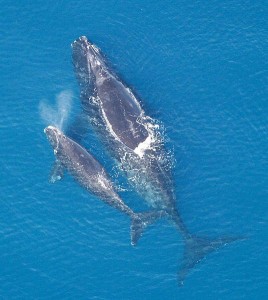Did you know that dolphins and porpoises are whales? We learned that, plus many other interesting facts about whales during our visit to the American Museum of Natural History’s exhibit Whales: Giants of the Deep. Admittedly I knew very little about whales before going to this exhibit. I didn’t know that the precursors to whales WALKED, losing their legs eventually as they took to the ocean full time. A simulation video of the whale’s evolution is a good visual representation.
Did you know that whales can be broken up into two categories: toothed whales and baleen whales? Toothed whales are smaller, and include dolphins and porpoises (porpoises don’t have beaks, dolphins do). Baleen whales are filter feeders, taking in larger amounts of small food and filtering it out, where as toothed whales go for single prey, swallowing it whole.
In addition to videos and other displays, the exhibit features 20 skulls and skeletons of whales, including a 58 foot male sperm whale skeleton (about 18 feet longer than a school bus).

Interesting facts:
- Whales can dive down more than 6,000 feet.
- Whales have the same genitals (penis/vagina) as humans, and mate belly to belly, usually under water.
- Female whales are pregnant for about a year, birthing their babies live – tail first, so the baby can begin swimming immediately. The baby can be 1/3 the mom’s length at birth.
- Toothed whales use echolocation to find their prey. They don’t use their teeth to chew/eat, but rather to fight with other whales.
- A killer whale is actually the largest dolphin.
- Babies are nursed for about 6 months, and the milk fat content is 16-46% (versus 3-5% for human milk).
- The blue whale heart is enormous, and a small child can fit inside an artery. Kids can crawl through a model of this whale heart at the exhibit.
- Whales are sexually mature at 8-10 years old.
- If you see the skeleton of a whale flipper, you’ll see bones shaped like a hand.
Movies/Interactive Exhibits:
The exhibit has plenty of short films that will capture the kids’ and adults’ attention. You’ll see a sperm whale diving for a meal of giant squid, his data captured by a D-tag that tracks depth and other statistics. There’s a whale rider video showing a very short clip of the movie and interviewing locals who tell stories of whale riding ancestors and tales. You’ll see a video about stranded whales as well.
Computer screens keep kids’ attention as they page through to learn more. And a selection of items carved out of whale bones, shows the history and importance of these bones in history.
Kids can crawl through a blue whale heart model at the exhibition.
Even if you didn’t know before going that the whale exhibit comes from New Zealand, you’ll figure it out pretty quickly when you see how many New Zealand references there are.
If you go:
When: now through January 5, 2014
Tickets: General admission plus the whales exhibit is $25/adult, $14.50/child, $19/senior or student. Members see the show for free. The museum has other combination of tickets/exhibits/movies you can purchase. General admission is $19/adult, $10.50/child, $14.50/senior or student. Get your ticket online ($2 fee/ticket extra) or at the ticket booth (you’ll have a better selection of times online ahead of time).
Tickets are timed, and the exhibits just inside the entrance can be mobbed. Further inside, the people disburse and it’s not as crowded. No strollers allowed.
Visiting the Museum: Read 7.5 ways to see the American Natural History Museum with kids here.

What age group would this be best for? My son is 3 but loves whales. Do you think this would be over his head?
Lauren – For a three year old, the best part would be crawling through the whale heart. He may like some of the movies and seeing the skeletons. My 9 year old was bored until he saw the movies. If you’re going to the museum anyway, it’s a worthwhile (and not terribly expensive) add-on. If you’re a museum member it’s free, so definitely worthwhile! Go on a weekday if possible – less crowded.
Wow! Me and my family have been traveling from the East coast every few years to go up and see the whales nearby the university district Seattle hotels area. With the economy a bit tougher we haven’t been able to go in a few years. I am so glad I found this while looking for travel options. You have made my two young whale loving girls very happy!